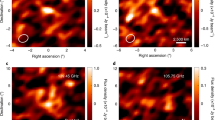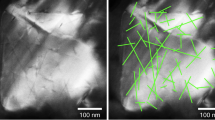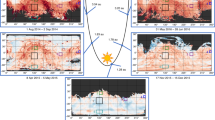Abstract
Comets are thought to preserve almost pristine dust particles, thus providing a unique sample of the properties of the early solar nebula. The microscopic properties of this dust played a key part in particle aggregation during the formation of the Solar System1,2. Cometary dust was previously considered to comprise irregular, fluffy agglomerates on the basis of interpretations of remote observations in the visible and infrared3,4,5,6 and the study of chondritic porous interplanetary dust particles7 that were thought, but not proved, to originate in comets. Although the dust returned by an earlier mission8 has provided detailed mineralogy of particles from comet 81P/Wild, the fine-grained aggregate component was strongly modified during collection9. Here we report in situ measurements of dust particles at comet 67P/Churyumov–Gerasimenko. The particles are aggregates of smaller, elongated grains, with structures at distinct sizes indicating hierarchical aggregation. Topographic images of selected dust particles with sizes of one micrometre to a few tens of micrometres show a variety of morphologies, including compact single grains and large porous aggregate particles, similar to chondritic porous interplanetary dust particles. The measured grain elongations are similar to the value inferred for interstellar dust and support the idea that such grains could represent a fraction of the building blocks of comets. In the subsequent growth phase, hierarchical agglomeration could be a dominant process10 and would produce aggregates that stick more easily at higher masses and velocities than homogeneous dust particles11. The presence of hierarchical dust aggregates in the near-surface of the nucleus of comet 67P also provides a mechanism for lowering the tensile strength of the dust layer and aiding dust release12.
This is a preview of subscription content, access via your institution
Access options
Subscribe to this journal
Receive 51 print issues and online access
$199.00 per year
only $3.90 per issue
Buy this article
- Purchase on Springer Link
- Instant access to full article PDF
Prices may be subject to local taxes which are calculated during checkout



Similar content being viewed by others
References
Dominik, C., Blum, J., Cuzzi, J. & Wurm, G. in Protostars and Planets V (eds Reipurth, B. et al.). 783–801 (Univ. Arizona Press, 2006)
Blum, J. Experiments on sticking, restructuring, and fragmentation of preplanetary dust aggregates. Icarus 143, 138–146 (2000)
Dollfus, A. Polarimetry of grains in the coma of 1P/Halley. Astron. Astrophys. 219, 469–478 (1989)
Kolokolova, L., Hanner, M. S., Levasseur-Regourd, A. C. & Gustafson, B. A. S. in Comets II (eds Festou, M. et al.) 577 (Univ. Arizona Press, 2004)
Kolokolova, L. & Kimura, H. Comet dust as a mixture of aggregates and solid particles: model consistent with ground-based and space-mission results. Earth Planets Space 62, 17–21 (2010)
Hanner, M. S. The scattering properties of cometary dust. J. Quant. Spectrosc. Radiat. Transf. 79–80, 695–705 (2003)
Brownlee, D. E. Morphological, chemical and mineralogical studies of cosmic dust [and discussion]. Phil. Trans. R. Soc. A 323, 305–311 (1987)
Flynn, G. J. et al. Elemental compositions of comet 81P/Wild 2 samples collected by Stardust. Science 314, 1731–1735 (2006)
Brownlee, D. et al. Comet 81P/Wild 2 under a microscope. Science 314, 1711–1716 (2006)
Dominik, C. Physical processes : dust coagulation and fragmentation. in ASP Conf. Ser. Vol. 414 (eds Henning, T. et al. .) 494–508 (Astronomical Society of the Pacific, 2009)
Johansen, A. et al. in Protostars and Planets VI (eds Beuther, H. et al. .) 547–570 (Univ. Arizona Press, 2014)
Skorov, Y. & Blum, J. Dust release and tensile strength of the non-volatile layer of cometary nuclei. Icarus 221, 1–11 (2012)
Bentley, M. S. et al. MIDAS : lessons learned from the first spaceborne atomic force microscope. Acta Astronaut. 125, 11–21 (2016)
Riedler, W. et al. MIDAS — the micro-imaging dust analysis system for the Rosetta mission. Space Sci. Rev. 128, 869–904 (2007)
Langevin, Y. et al. Typology of dust particles collected by the COSIMA mass spectrometer in the inner coma of 67P/Churyumov Gerasimenko. Icarus 271, 76–97 (2016)
Hilchenbach, M. et al. Comet 67P/Churyumov–Gerasimenko: close-up on dust particle fragments. Astrophys. J. 816, L32 (2016)
Paszun, D. & Dominik, C. The influence of grain rotation on the structure of dust aggregates. Icarus 182, 274–280 (2006)
Stephens, J. R. & Gustafson, B. Å. S. Laboratory reflectance measurements of analogues to “dirty” ice surfaces on atmosphereless solar system bodies. Icarus 94, 209–217 (1991)
Rotundi, A. et al. Combined micro-Raman, micro-infrared, and field emission scanning electron microscope analyses of comet 81P/Wild 2 particles collected by Stardust. Meteorit. Planet. Sci. 43, 367–397 (2008)
Stodolna, J., Gainsforth, Z., Butterworth, A. L. & Westphal, A. J. Characterization of preserved primitive fine-grained material from the Jupiter family comet 81P/Wild 2 — a new link between comets and CP-IDPs. Earth Planet. Sci. Lett. 388, 367–373 (2014)
Wozniakiewicz, P. J., Bradley, J. P., Ishii, H. A., Price, M. C. & Brownlee, D. E. Pre-accretional sorting of grains in the outer solar nebula. Astrophys. J. 779, 164 (2013)
Greenberg, J. M. & Gustafson, B. Å. S. A comet fragment model for zodiacal light particles. Astron. Astrophys. 93, 35–42 (1981)
Levasseur-Regourd, A. C., Mukai, T., Lasue, J. & Okada, Y. Physical properties of cometary and interplanetary dust. Planet. Space Sci. 55, 1010–1020 (2007)
Lasue, J. & Levasseur-Regourd, A. C. Porous irregular aggregates of sub-micron sized grains to reproduce cometary dust light scattering observations. J. Quant. Spectrosc. Radiat. Transf. 100, 220–236 (2006)
Mathis, J. S. Interstellar dust and extinction. Annu. Rev. Astron. Astrophys. 28, 37–70 (1990)
Greenberg, J. M. & Hage, J. I. From interstellar dust to comets: a unification of observational constraints. Astrophys. J. 361, 260–274 (1990)
Fulle, M. et al. Comet 67P/Churyumov–Gerasimenko: the GIADA dust environment model of the Rosetta mission target. Astron. Astrophys. 522, A63 (2010)
Necˇas, D. & Klapetek, P. Gwyddion: an open-source software for SPM data analysis. Cent. Eur. J. Phys. 10, 181–188 (2012)
Acknowledgements
Rosetta is an ESA mission with contributions from its member states and NASA. We also thank the Rosetta Science Ground Segment and Mission Operations Centre for their support in acquiring the presented data. MIDAS became possible through support from funding agencies including the European Space Agency’s PRODEX programme, the Austrian Space Agency, the Austrian Academy of Sciences and the German funding agency DARA (later DLR). A.-C.L.-R. acknowledges support from the French Space Agency, CNES. M.S.B. and T.M. acknowledge funding from the Austrian Science Fund (FWF): P 28100-N36. T.M. also acknowledges the Steiermärkische Sparkasse and the Karl-Franzens Universität Graz for their financial support. P.E. acknowledges support from the NASA Astrobiology Institute. R.S. thanks F. Hofer and H. Plank for discussions and the Austrian Research Promotion Agency (FFG) for financial support. All data presented here will be made available in the ESA Planetary Science Archive (http://www.cosmos.esa.int/web/psa/rosetta).
Author information
Authors and Affiliations
Contributions
R.S., T.M. and M.S.B. planned the experiments on MIDAS, analysed and interpreted the data and wrote the manuscript. M.S.B. developed the planning and data processing pipelines. R.S. and T.M. implemented the elongation calculations. R.S. performed the post-processing and calibration as well as the particle/grain measurement and is responsible for the graphical data presentation. T.M. considered the uncertainties for all data. A.-C.L.-R. provided information on cometary dust derived from polarimetric observations and its interpretation. H.J. supported the experiments with software updates. All authors discussed the results and commented on the manuscript.
Corresponding author
Ethics declarations
Competing interests
The authors declare no competing financial interests.
Additional information
Reviewer Information Nature thanks M. Fulle and L. Kolokolova for their contribution to the peer review of this work.
Extended data figures and tables
Extended Data Figure 1 The geometry of the exposures where particles A, B and C were collected.
All exposures are marked by green bars. The top panel shows the distance of Rosetta from the comet (blue) and the off-nadir angle (red). The lower panel shows the latitude and longitude of the point on the comet below the spacecraft (the sub-spacecraft latitude and longitude) in blue and red, respectively. The heliocentric distance (between the comet and the Sun) during this exposure was 2.25 au.
Extended Data Figure 2 The geometry of the exposures where particle D was collected.
All exposures are marked by green bars. The top panel shows the distance of Rosetta from the comet (blue) and the off-nadir angle (red). The lower panel shows the sub-spacecraft latitude and longitude in blue and red, respectively. The heliocentric distance during this exposure varied between 2.54 au and 2.41 au.
Extended Data Figure 3 The geometry of the exposures where particle E was collected.
All exposures are marked by green bars. The top panel shows the distance of Rosetta from the comet (blue) and the off-nadir angle (red). The lower panel shows the sub-spacecraft latitude and longitude in blue and red, respectively. The heliocentric distance during this exposure varied between 2.85 au and 2.52 au.
Extended Data Figure 4 Topographic cross-sections demonstrating the identification of sub-units.
a, Topographic image of particles A, B and C. Dashed blue, red and green lines show where the cross-sections of particle A, B and C, respectively, were made. The colour scale represents the height. b, Height profiles of the three cross-sections shown in a, demonstrating how sub-grains were identified (blue and green arrows) and revealing slopes of 60°–70° with the substrate surface.
Extended Data Figure 5 Tip–sample convolution effects.
a, b, Simulated AFM images (colour scale indicates the height) providing a comparison between a spherical particle imaged with an ideal, infinitely sharp tip (a) and with a cone-shaped tip with an opening angle of 30° (b), which is similar to that of the MIDAS tips14. c, d, The corresponding cross-sections through the centre of the structures (y axis shows the height). The black dashed curves show the spherical particle and the blue lines depict the topography as measured with infinitely sharp and cone-shaped tips, respectively. The measurement of the volume of the spherical particle is exaggerated by 25% for the delta-shaped tip and by 50% for the cone-shaped tip. The maximum height measurement is not affected by the tip–sample convolution.
Rights and permissions
About this article
Cite this article
Bentley, M., Schmied, R., Mannel, T. et al. Aggregate dust particles at comet 67P/Churyumov–Gerasimenko. Nature 537, 73–75 (2016). https://doi.org/10.1038/nature19091
Received:
Accepted:
Published:
Issue Date:
DOI: https://doi.org/10.1038/nature19091
This article is cited by
-
An atomistic study of sticking, bouncing, and aggregate destruction in collisions of grains with small aggregates
Scientific Reports (2024)
-
Bouncing and spinning of amorphous Lennard-Jones nanoparticles under oblique collisions
Scientific Reports (2022)
-
Collisions between CO, CO\(_2\), H\(_2\)O and Ar ice nanoparticles compared by molecular dynamics simulation
Scientific Reports (2022)
-
The Plasma Environment of Comet 67P/Churyumov-Gerasimenko
Space Science Reviews (2022)
-
Bouncing of Hydroxylated Silica Nanoparticles: an Atomistic Study Based on REAX Potentials
Nanoscale Research Letters (2020)
Comments
By submitting a comment you agree to abide by our Terms and Community Guidelines. If you find something abusive or that does not comply with our terms or guidelines please flag it as inappropriate.



